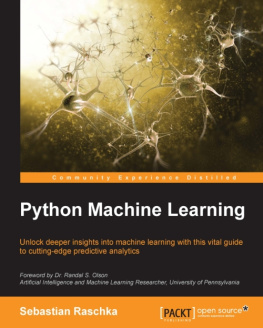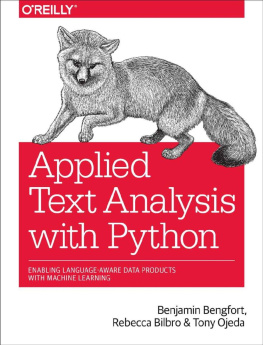Natural Language Processing in Python
Master Data Science and Machine Learning for spam detection, sentiment analysis, latent semantic analysis, and article spinning
By: The LazyProgrammer ( http://lazyprogrammer.me )
Introduction
Recently, Microsofts Twitter bot Tay was released into the wild, and quickly began making racist and hateful statements after learning from other Twitter users. The technology behind this? Natural language processing.
Natural language processing is the use of machine learning algorithms for problems that involve text.
This is one of the most important problems of our day because a lot of the Internet is made up of text. With NLP, we can analyze it, understand it, categorize it, and summarize it - and do it all automatically.
Do you ever wonder why you get much less spam in your inbox these days compared to 10 years ago? What kinds of algorithms are people using to do spam detection? How can they take words in an email and know how to compute whether or not its spam? In this book you are going to build your very own spam detector.
Did you know people have already used Twitter to determine the current sentiment about a particular company to decide whether or not they should buy or sell stocks? Having a machine that can decide how people feel about something is immensely useful and immediately applicable to revenue optimization. In this course you are going to build your own sentiment analyzer.
Are you an Internet marketer or are you interested in SEO? Have you ever wanted to know how you can automatically generate content? In this course we are going to take a first crack at building your own article spinner. Youll learn to write programs that can take an article as input and spit out a similar article with different words as output. This can save you tons of time and thousands of dollars if youre paying someone to write content for you.
Natural Language Processing, or as it is often abbreviated, NLP - is the use of programming and math to do language-based tasks.
If you have Windows or iOS then you have NLP right in front of you! Cortana and Siri are applications that take what you say and turn it into something meaningful that can be done programmatically.
The key point: NLP is highly practical. NLP is everywhere.
This book is split up into multiple sections based on the various practical tasks that you can do with NLP:
Before we do any real programming exercises well look at common NLP tasks (some of these we will actually code ourselves, the others are mentioned so you at least know they exist). We will then look at common data pre-processing techniques used for text. As youll see, this preprocessing is what will actually take up a majority of your time when youre doing NLP.
The first programming exercise well do is look at how to build a spam detector. Your email inbox uses this, so its clearly very useful and its been the subject of study for a long time.
Next well look at sentiment analysis and youll build your own sentiment analyzer. This is how a computer can judge how positive or negative some text is based on the words and phrases that are used. This is also immediately practical - some people have analyzed Twitter feeds to predict whether a stock would go up or down.
After that well look at the NLTK library. This is a very popular library that solves a lot of fundamental problems in NLP - and you can use it in conjunction with other libraries in your data analysis pipeline.
Next well look at latent semantic analysis. This is basically doing dimensionality reduction on text - and it helps us solve the problem of 2 words having the same meaning. It also helps us interpret our data and save on computation time.
Lastly, well talk about one of the most popular applications of NLP - article spinning. This is very practical for internet marketers and entrepreneurs. As you know, your search rankings in Google and other search engines are affected negatively when you have duplicate content - so it would be great if you could alter an article you wrote just enough, so that you could put it in 2 different places on the web, without being penalized by Google.
This book requires a minimal amount of math to understand. If there is math, its for your own interest only, but its not vital to completing the programming parts. Of course, you will still need to know how to code, since NLP is primarily in the domain of programming, but Ive designed this book to require a lot less math than some of my other books on deep learning and neural networks.
All of the materials required to follow along with this book can be downloaded for FREE. We use Python, NLTK, Sci-kit learn, and Numpy, all of which can be installed using simple commands.
Chapter 1: What is NLP all about?
Since NLP is really just the application of machine learning and software engineering to text and language problems, I think its very important in this case to talk about - what are these applications? And how are they useful in real life?
In this chapter Im going to go through some real applications of NLP and talk about how good we are at solving these problems with current technology. A lot of this book is going to skip over the theory and instead well talk about, how can we code up our own solutions to these NLP problems using existing libraries? Well go through a few problems where the state of the art is very good, then well go through some problems where the state of the art is just pretty good but not excellent, and then well go through some problems where the state of the art kind of works but there is definitely room for improvement.
Here are some problems that we are currently very good at solving:
Spam detection : I almost never get spam anymore in my email. Gmail even has algorithms that can split up your data into different tabs, such as the social tab for social media related posts, and the promotions tab for marketing emails.
Parts of speech (POS) tagging : We want to know which terms in a sentence are adverbs, adjectives, nouns, pronouns, verbs, and so on. We are very good at classifying these.
Input:
The quick brown fox jumps over the lazy dog.
Output:
(Determiner, adjective, adjective, noun, plural noun, )
There are many online tools out there that can demonstrate this, for example: http://parts-of-speech.info/
Named entity recognition (NER) :
Input: Jim bought 300 shares of Apple in 2006.
We want to be able to recognize that Jim is a person, Apple is an organization, and 2006 is a date.
There are some problems that we are pretty good at but not great at:
Sentiment analysis : This is something were going to cover in this course. Lets say youre looking at hotel reviews on the web, and you want to know if overall, people think this hotel is good or bad. Well you can do this by reading the reviews yourself - but if we want the machine to assign a positive or negative score, its not that simple. One problem (among many others) is that machines cant easily detect sarcasm. So if you say something where the words mean the opposite of their true definition, then this will confuse the machine.
Machine translation : This is a tool like Google translate. Take a phrase and convert it through a few different languages. Youll see that when we return to English, the result wont make much sense. [Exercise: Try this on your own]
Information extraction : This is how iOS is able to add events to your calendar automatically by reading your email and text messages. Its able to tell that this is a string of text that represents a calendar event.
And here are some problems that weve attempted but were not close to perfect at all:
Machine conversations : We have apps like Siri and Cortana where you can say simple phrases to command the computer to do something, and thats actually a very hard problem. There is an extra stage here in addition to just text processing, which is that it has to translate your voice into a string of words. To use Geoff Hintons favorite example, recognize speech, sounds almost the same as wreck a nice beach - but using probabilistic analysis we can conclude that recognize speech is more likely.










